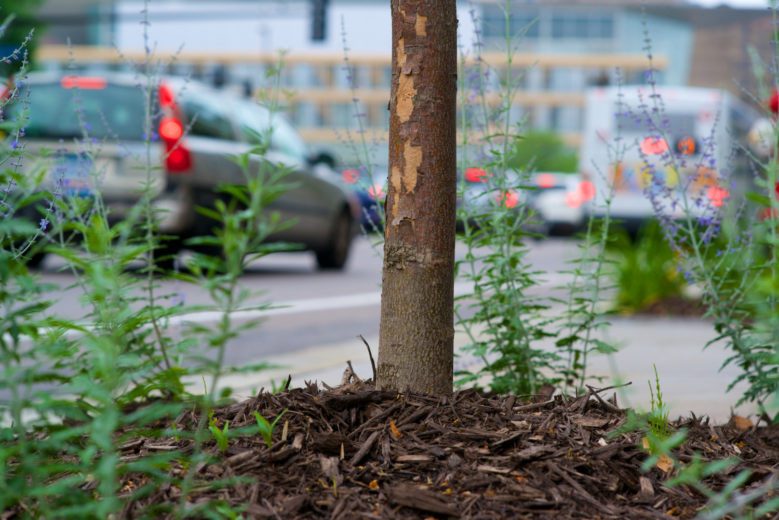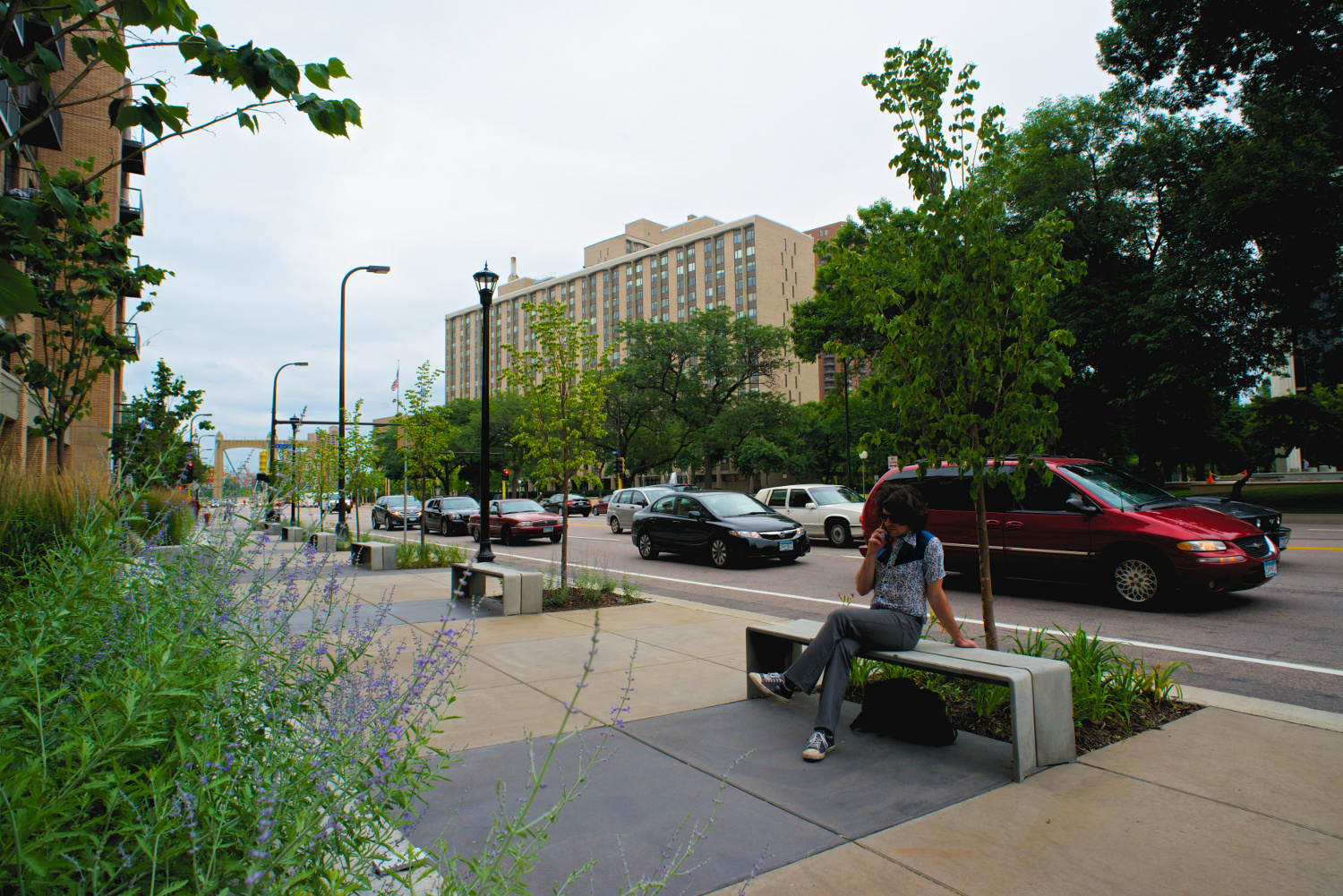In part one of this series, we gave recommendations for how to address tree maintenance needs in a smarter and more financially (and ecologically) sustainable way. In part two, we shared specific lessons from other cities that I was aware of – and asked you to reach out and share your experience. Today, we’ll share some of the ideas you sent us and, wherever possible, link to resources where you can read more.
This list is far from complete – keep sending your ideas and best practices around tree care maintenance to [email protected] and we’ll update this post accordingly.
Stewardship matters – a lot
(East Palo Alto, CA and Philadelphia, PA)
“Urban tree planting initiatives aim to provide ecosystem services that materialize decades after planting, therefore understanding tree survival and growth is essential to evaluating planting program performance” begins the abstract of a recent paper from Lara Roman and several other authors called Stewardship Matters (Urban Forestry & Urban Greening, November 2015).
In many communities, tree planting and care is done by local non-profits composed of a few full-time staff members and a fleet of volunteers – and the survival of the trees planted by these programs can vary widely. Since tree survival is essential to the later realization of ecological benefits, Roman and her colleagues decided to investigate programs with high tree survivorship to better understand what factors help young trees survive their early years (the establishment period).
After assessing two urban tree planting programs with extremely high rates of establishment survival (95.4% – 99.4%), the team concluded that stewardship was a key factor in their success. In their concluding paragraphs, the authors offered the following thoughts: “The time invested by staff and volunteers to planting and maintenance activities served as a manifestation of the sense of responsibility for these trees, and indicates the interconnectedness of multiple meanings of stewardship described by Romolini et al.(2012). We documented specific tree care practices, and propose that these activities were intricately linked to program processes at these nonprofit organizations, and ultimately, to a broader sense of motivation and ownership toward urban forests.”
They also offered the following lessons:
- Some urban tree losses are inevitable, even in the most optimal circumstances.
- Neighborhood-scale operations are well-suited to stewardship.
- Data management strategies facilitated monitoring.
- Planting programs prioritized substantial time for tree care.
Watering program and continuous soil
Vincent Verweij, Arlington County (VA) Forester, wrote in to tells us about several programs that the county runs as best practices. Preservation of trees on private and public projects, as well as replanting, are their priorities, as this is where the majority of their urban tree canopy exists. Their initiatives include:
- Their own watering program providing 2 years of watering for newly-planted trees;
- Required replacement and maintenance from other departments and private projects which remove trees;
- Continuous soil volumes for tree pits in more urban areas of the county;
- Prioritize planting native species over non-native species for street trees.
The county is also exploring soil volume targets.
Arlington’s updated Administrative regulation 4.3 will have some of the above guidelines in them. Vincent helps write the Natural Arlington blog.
Integrate disciplines
(Palo Alto, CA)
The planning department for Palo Alto, CA includes an unusual member – an arborist.
Dave Dockter is an arborist with the Department of Planning and Community Environment and Public Works. This role merged with a new Urban Forestry section with Public Works, primarily involved with all development review services. As an expert in trees who also works within the building permit and planning department role, Dave has a unique perspective on working with developers to overcome pressing challenges to the urban forest – and a unique opportunity to make an impact on the city’s urban forest.

In Palo Alto, the land use entitlement and development process is when most damage to trees tends to happen, or limitations are imposed – and it is also the optimum phase to preserve existing trees and planning for new canopy trees can be achieved. Because of this combination of factors, the City Council wanted an in-house arborist to be involved in the planning process. Dave’s responsibilities range from writing documents such as tree codes and technical manuals, to advising during planning and entitlement review for development projects.
Palo Alto doesn’t have a soil volume requirement, but Dave is able to work with developers to provide large quantities of soil to trees. Tree related conditions of approval (enabled by discretionary review) are available to any city to utilize per California laws. When discretionary review is applied to a commercial property development, it means the city can write special tree-related conditions that must be followed in the building permit. For example, public works may say the sidewalk needs to be replaced, or the curb and gutter altered somehow. Similarly, providing more soil for street trees can be one such condition, and complex commercial projects can have hundreds of conditions of approval.
Read our full interview with Dave here.
Implement a credit system
(multiple locations)
Many jurisdictions provide incentives to preserve existing trees and plant new ones in the form of grants, rebates, stormwater fee discounts, and stormwater credits. This last one – stormwater credits – is often especially persuasive.
Impervious surface reduction credits are offered when the presence of trees reduces the overall amount of impervious surface that has to be treated. Such credits have been adopted in:
- San Jose, CA
- Santa Clara Valley, CA
- Indianapolis, IN
- Minneapolis, MN
- Portland, OR
- Philadelphia, PA
- Austin, TX
- Seattle, WA
Volume reduction credits are granted based on the assumed amount of stormwater volume that is reduced based on a tree’s size. For example, Pine Lake, GA, provides 10 gallons of credit per inch of the diameter at breast height (DBH) for preserving existing trees under 12” DBH, and 20 gallons of credit per inch ofDBH for preserving existing trees over 12” DBH. (DBH is tree diameter measured at 4.5 ft. (137 cm) above ground level). Such credits have been adopted in:
- Washington DC
- Pine Lake, GA
- Minnesota Minimal Impact Design Standards (MIDS)
Invest in your tree inventory
(multiple locations)
Many cities, maybe most, struggle to maintain and grow their urban tree canopy. Where should new trees be planted? Which ones should be removed? What species are overrepresented? This effort is made even more difficult if an up to date tree inventory is not available (you know the saying – if you can’t measure it, you can’t manage it).
There are a number of tools to create low cost, or even free, urban tree inventories. Most use an open-source software (such as Azavea’s OpenTreeMap) and volunteers to add trees and create a living inventory. The inventory data can then be used to quantify the ecosystem services provided by trees, whether in CO2 reduction, air quality improvement, or stormwater management (the calculations are made using i-Tree).
Cities across the U.S., including San Francisco, Philadelphia, and New York, have created open urban trees maps with great success. While any really thorough tree inventory will require both effort and money, it does not need to be a huge investment – and could pay dividends when making the economic argument for the benefit of the urban forest.
Read more about urban tree maps here.
* * *
Remember that tree maintenance needs to occur throughout a tree’s life – starting from before it’s even planted. Thank you to those of you who shared the best management practices for tree care and maintenance from your cities and towns. By continuing to share information like this, we can hopefully make better decisions that secure the future of our urban forests.






wonderful article and really well down written article you have here. I personally have never heard about tree maps before in the several major cities you mentioned above. Which one do you think above is the best one to use tree maps in?
“Remember that tree maintenance needs to occur throughout a tree’s life – starting from before it’s even planted.”
This is an extremely important statement that I wish more people would understand. Thank you for this great article.
Fantastic insight! I’m in the tree service industry and didn’t know half of what you guys have written here. Thanks!
Keep planting near commercial complex, this will help for better environment.
I like the incentive programs, because they definitely allow beneficial things to the society (like planting trees) to take root.
Boom! Love seeing Indy on the list of cities that implemented the credit system. Feeling that Indy pride right about now!
Interesting to read about how other areas of the country are compared to us, out here in Arizona. We don’t have nearly as many large trees as the desert trees are much smaller. So when it comes to urban planting, we don’t deal with near as many logistical issues.